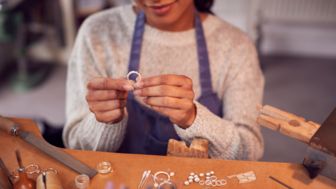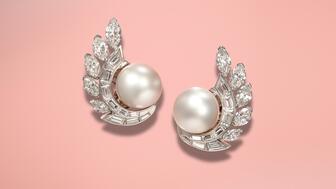The entrepreneur and “Shark Tank” star will share his top tips for success.
70% of Consumers Are Interested in Ethically Sourced Gold
That number is expected to increase as Generation Z gets older and, hopefully, starts buying more jewelry, the World Gold Council found in a new survey.

The London-based organization questioned more than 18,000 investors and consumers in six countries—the United States, India, China, Canada, Germany and Russia—to discern their attitudes about gold as an investment and adornment.
Overall, the survey found that among the 6,115 consumers surveyed, 48 percent have bought gold in the past/would consider buying again, while 38 percent have never bought gold but haven’t ruled it out as a purchase.
Only 13 percent said they will never buy gold.
The survey also showed consumers are interested in where their gold comes from and what impact it has on the people who mine it.
And the younger consumers are, the more concerned they’re likely to be.
The Conscious Consumer
Ethical and environmental issues do not necessarily stop potential gold buyers from getting a piece, with only 23 percent of survey-takers citing these concerns as a barrier to purchase.
But when describing their ideal gold jewelry purchase, 70 percent of gold jewelry buyers said they would like to purchase pieces that are “produced ethically,” with minimal impact on the environment and fair and modern working conditions for those who mine it.
In an interview with National Jeweler on Monday, World Gold Council Director of Market Intelligence Alistair Hewitt said consumers want more information about the origin of their gold, and the industry could do a better job educating them.
“Responsibly sourced and responsibly mined gold is hugely important, and the vast majority of the gold mined in this world is produced in a responsibly sourced way,” he said.
“More could be done in communicating that to end consumers.”
Environmental concerns are particularly pronounced among Gen Z consumers, who are roughly 9 to 22 years old (though only those ages 18-22 were included in the survey).
Some members of this up-and-coming generation feel they face an uncertain future due to environmental destruction; they are the generation staging school strikes over climate change, sparked by one of their peers, 16-year-old Greta Thunberg of Sweden.
In the U.S., 18 percent of consumers ages 39 and up and 19 percent of millennials (ages 23-38) said they would buy gold jewelry within the next 12 months. That number slips to 11 percent among Gen Zers.
The biggest drop-off in Gen Z purchases of gold is in China, where only 12 percent of consumers in this age group intend to buy gold jewelry in the next year, compared with 37 percent of millennials and 42 percent of those age 39 and up.
Hewitt said this largely due to a shift in values, as younger Chinese consumers, brought up in a world in which they have more income, technology and choices, do not have the same connection to gold as their parents.
“It’s a real battle to engage with these people because they don’t necessarily want to be going into a jewelry store buying jewelry. They might want to be going off and enjoying a holiday [instead].
“The experiential purchase is hugely significant in Gen Z across the board, but especially in China. There’s even more intense competition for a share of their wallet that’s drawing their attention away [from jewelry].”
Social and environmental concerns around gold are expected to become more important in the years ahead as more members of Gen Z age into adulthood.
As the report put it: “As they become older, and richer, this will become even more relevant.”
Other Takeaways
Here are five more points of interest from the World Gold Council’s survey on gold jewelry buying.
— Trust is an issue. Among those surveyed who said they’ve never bought gold jewelry but would consider it, 28 percent said a lack of trust was a significant barrier to purchase, with 19 percent concerned about the metal’s purity (18 karat, 14 karat, etc.) being as represented and 14 percent saying they don’t trust the retailers who sell gold.
— Online sales lag. Among competitors, gold jewelry is the least likely (14 percent) to be bought online, trailing silver (21 percent), diamonds (17 percent) and platinum (25 percent).
Hewitt said wedding purchases in India and China, which are traditionally done in person, contribute to gold’s falling behind online.
The report noted: “If buyers are convinced by a website’s trustworthiness, and the ability to return items, and they are engaged in a purchasing experience within a secure environment, they will be more likely to use an online platform.”
— Millennials in the U.S. pick rose gold more often than older consumers. Among those ages 23-38, 31 percent said they bought or received a piece of rose gold jewelry in the past 12 months, compared with 15 percent of those age 39 and up.
— Gen Yers also like white gold. Among those ages 23-38, 35 percent received a piece of jewelry that is white gold, compared with 30 percent of those ages 39 and up.
The percentage comparisons for yellow gold were 51 and 62, respectively.
— For some, gold is too “flashy.” Three-quarters of gold considerers globally don’t buy because of “fashion barriers.” They feel gold can come across as “too flashy” and may opt for silver or diamonds instead, the survey states.
A microsite detailing the findings on a more granular level, RetailInsights.gold, went live Tuesday morning.
Hewitt said WGC will complete more detailed reports for each country, including the U.S., and hopes to publish them in the next six months.
“This is a big, high-level thematic report. The real value for the industry, I think, will probably come when we delve down into the country and sector-specific reports,” he said.
The Latest

The Ukrainian brand’s new pendant is modeled after a traditional paska, a pastry often baked for Easter in Eastern European cultures.

The jeweler has announced a grand reopening for its recently remodeled location in Peoria, Illinois.

The “Strong Like Mom” campaign features moms who work at Tiffany & Co. and their children.


Interior designer Athena Calderone looked to decor from the 1920s and 1930s when crafting her first fine jewelry collection.

During a call about its full-year results, CEO Efraim Grinberg discussed how the company is approaching the uncertainty surrounding tariffs.

Bench jewelers spend years honing their skills, Jewelers of America’s Certification validates their talents.

The free program provides educational content for jewelry salespeople and enthusiasts to learn or refresh their diamond knowledge.

The feedback will be used to prepare other jewelers for the challenges ahead, the organization said.

The online sessions are designed to teach jewelers to use AI tools like ChatGPT and Claude to grow their business.

The opening marks the jewelry retailer’s first location in the Midwest.

The “United in Love” collection offers tangible mementos of hearts entwined with traditional and non-traditional commitment heirlooms.

Robert Goodman Jewelers will hold a “Black Jewelry Designers and Makers” event on April 27.

The announcements follow a tumultuous start to 2025 for WJA, which saw a wave of resignations following controversial statements about DEI.

Editor-in-Chief Michelle Graff answers questions about how the new taxes levied on countries like India and China will impact the industry.

Kenewendo, Botswana’s minster of minerals and energy, discusses closing the deal with De Beers and the work that was missed along the way.

The historic fancy vivid blue diamond set to headline Christie’s Geneva sale next month could sell for up to $50 million.

LVMH CFO Cécile Cabanis also discussed the effects of tariffs so far.

The “Mad Men” and “The Morning Show” star steals jewelry, art, and handbags from his wealthy neighbors in “Your Friends & Neighbors.”

The organization has reelected Kalpesh Jhaveri as president.

An investigation found that the former managing director of Movado’s Dubai branch overstated and prematurely recorded sales.

The collection pays tribute to the Japanese philosophy of Ma, studying balance, stillness, and the interplay between presence and absence.

Mari Lou’s Fine Jewelry in Orland Park, a suburb of Chicago, is closing its doors.

GIA’s labs in Dubai and Hong Kong are now accepting larger diamonds in light of the “logistical challenges” presented by the new tariffs.

These earrings by Van Cleef & Arpels, featuring the same design as a pair worn by Princess Grace, are up for auction at Woolley & Wallis.

Two experts share how artificial intelligence tools can help retailers run a more efficient business.



























